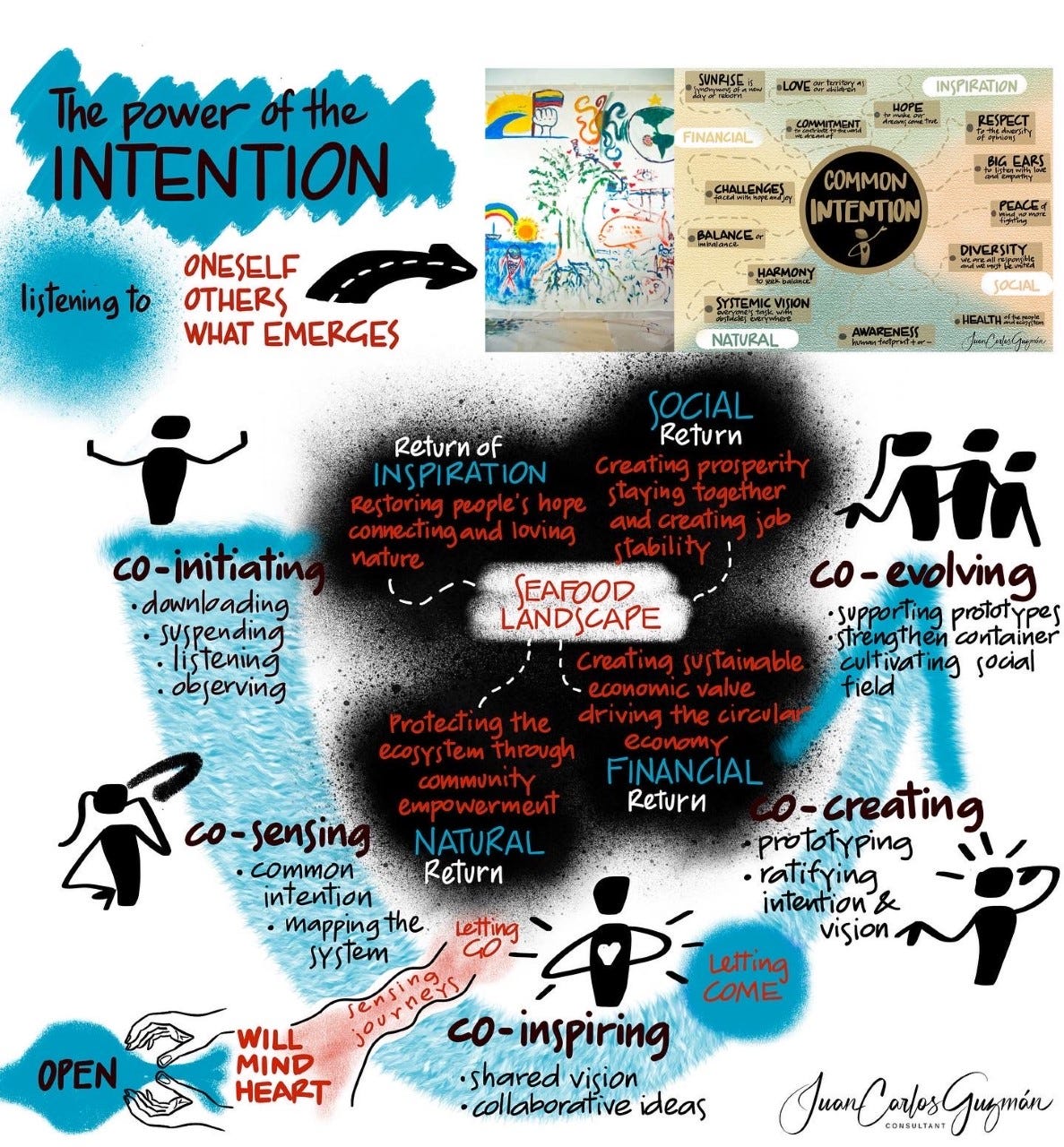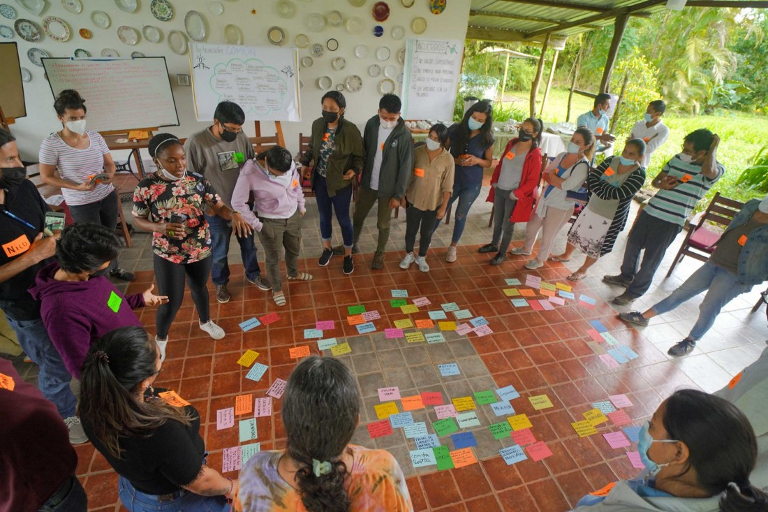A process of intention, vision, and prototypes — centered in the seafood system of the Galápagos — with frameworks of Theory U and the 4 Returns.
An overview of the Galapagos Seafood System Vision Project. In the upcoming months, Juan Carlos Guzmán will share his expanded reflections on the process.
Responsible Fishing, “Transparency and Trust,” “Make Visible the Invisible,” and “Listen Deeply.”
The Galapagos island territory sits off the coast of Ecuador, encompassing the island archipelago, the surrounding waters, a national park and a marine reserve. The area is known for high biodiversity and among the highest levels of endemism on the planet (species that are found nowhere else). The islands and coast are home to a wide array of communities of people involved in the seafood system for decades, a web of social connections either directly or indirectly embedded in the reality of the sea. Facing the shifting and challenging environmental, social, and economic conditions, the community, local organizations, and the Galapagos Governing Council saw the need to understand the sea food system jointly with the community with the aim of later building public policies on food security for this special regime.
For the construction of a comprehensive public policy around the seafood system in the archipelago, the following objectives were set:
- Co-create an intention of the stakeholders, who will support the process.
- Co-build the vision of the Galapagos seafood system.
- Co-identify prototypes that help implement this vision.
The resulting vision would assist in building public policy. It also would align with the objectives of the Plan Galápagos 2030, the Plan of Management of Protected Areas, and the Plan de Management of “Áreas Protegidas de Galápagos para el Buen Vivir.” In addition, the vision would reach across silos of the sustainable development goals, addressing a range of SDGs including: Zero Hunger (SDG 2); Gender Equality (SDG 5); Decent Work (SDG 8); Sustainable Communities (SDG 11); Responsible Consumption and Production (SDG 12); Life below Water (SDG 14); and Peace, Justice (SDG 16).
The group created a common and unifying intention, which motivated both the co-construction of the vision and the development of prototype ideas to experiment with, learn from, and iterate. The intention was essential for building a container to continue working collectively in benefit of the seafood system of the Galapagos and the social and ecological collective. In a span of several months, participants individually and collectively experienced the U process, using tools and methods of systems sensing and presencing practices.
“This co-creation process allowed us to demonstrate to ourselves that by listening deeply, collaborating actively, and un-learning constantly, we can make things happen.” — Juan Carlos Guzmán
Co-Construction and Mapping the System: Two Interweaving Systemic Approaches
Seeking methodological approaches that were participatory and systemic — meaning, inclusive of actors across the system, from those working in fisheries, to those consuming seafood, to those working in communities or government, to those guiding nature tourism in the area — the frameworks of Theory U and the 4 Returns were selected to guide the co-creation of intention, vision, and prototypes. The 4 Returns framework, developed by Commonland and partners, provides extensive knowledge of long-term ecological restoration and centers reflection and action far beyond the financial return of initiatives, recognizing that this is only one ‘return,’ which must exist alongside three other critical returns: the social, natural, and return of inspiration. Theory U engages stakeholders around transformation, bringing together the disciplines of systems thinking, awareness-based practices, and action learning. Over the course of nine months, the process included 70 participants across four working sessions, as well as a learning trip and a series of workshops to collectively identify prototype ideas.
The first step: to make a map of actors in the Galapagos seafood system, to support the goal of a co-created and inclusive vision. Key people were interviewed as input to design the co-creation process. The following sectors participated: fishing and fisheries sector, government, chefs, naturalist guides, entrepreneurs, the food service sector, the agricultural sector, youth organizations, women’s organizations, the science field, the transformation field, other professionals, and local NGOs. From this group of over 70 people from all corners of the system, the Container of Social Innovation of the Food System of the Galapagos Sea was born.



From Co-initation to Co-Evolving, taking time to travel together to go up and down the U to get there, integrated with the 4-Returns. Images from Juan Carlos Guzmán.
Emerging Prototypes
In initially developing the prototypes in a simplified manner and aimed at learning-by-doing, with the principle of collaboration and trial and error, the participants were encouraged to learn collectively and to implement solutions to problems identified. 10 prototype ideas were defined together, under the principles of collaboration, inclusion and contribution to the sea food system of Galapagos. The ideas were accompanied by orientation and motivation. Some of these prototypes have already been turned into real-world initiatives, receiving further support and acceleration. Others remain in stages of experimentation to be configured into ventures that can be implemented in the medium and long term. See the journey of one initiative’s experience from problem to prototype below, navigating the process to create a sustainable start-up and build collective alliances with others in the community.
The journey of one initiative’s experience from problem to prototype, collectively navigating the process to create a sustainable start-up and build alliances with others in the community.
The Galapagos Seafood System Vision
The expanded vision, addressing the 4 Returns: Financial Returns, Natural Returns, Social Returns, and Return of Inspiration — recognizing that all is interlinked. Image from Juan Carlos Guzmán.
Convening Entities: Pesca Galápagos, Global Environmental Facility (gef); Grupo Banco Mundial, Presencing Institute, Commonland, Conservation International, Fundación Charles Darwin Galapagos.





